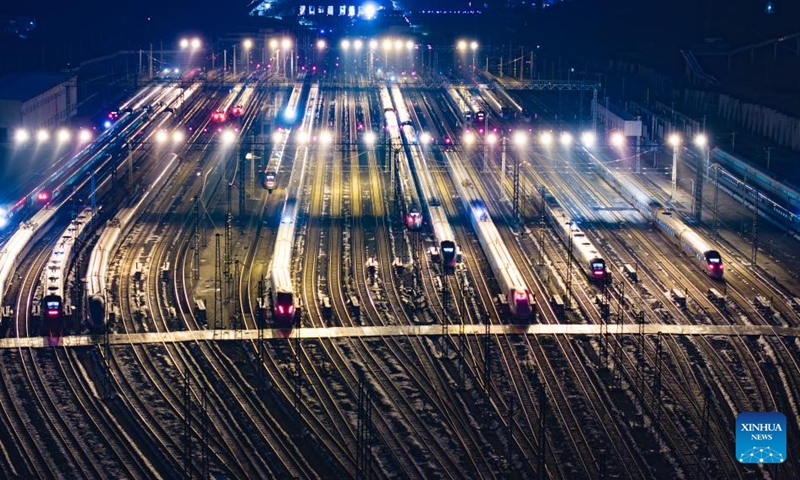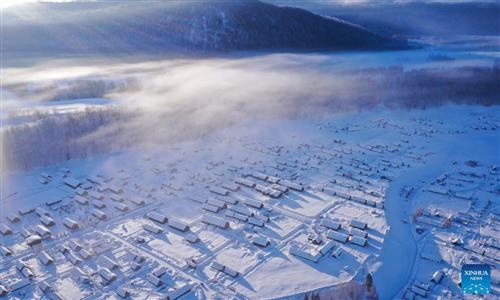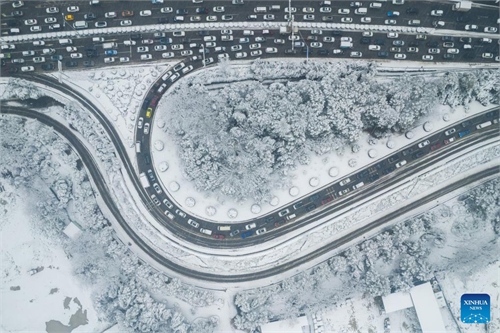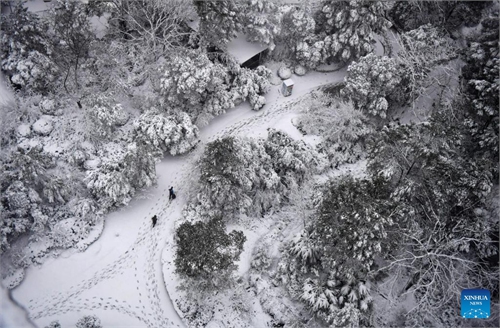Central govt requests all departments ensure safety of people, property and happy holidays as extreme weather sweeps China during Spring Festival travel rush

An aerial drone photo taken on Jan. 25, 2024 shows bullet trains at Guiyang North bullet train maintenance station in Guiyang, southwest China's Guizhou Province. The Spring Festival, China's biggest traditional festival, will fall on Feb. 10, while the Spring Festival travel rush, usually a period of high transportation demand as people return home for family reunions, will run from Jan. 26 to March 5.(Photo: Xinhua)
When the strongest rain and snow freezing weather in about 15 years sweeps across central and eastern China, estimated to strain travel for millions over the next few days during the Spring Festival travel rush, the General Office of the Central Committee of the Communist Party of China and the General Office of the State Council issued the Notice on the Prevention and Response of Low Temperature, Rain, Snow and Ice Disasters before and after the Spring Festival, requiring all departments to make every effort to ensure the safety of people and property and the overall stability of society, and to ensure that people have a happy and peaceful festival.
In particular, the transportation department should strengthen scheduling for the peak of the Spring Festival travel rush, timely allocate transportation vehicles and personnel, release flight and train adjustment information in a timely manner, guide passengers to travel reasonably and flow in an orderly manner, and minimize the impact caused by freezing disasters, according to the notice.
It is necessary to improve the early warning response linkage mechanism and make full use of multimedia multi-frequency release of forecast warning and disaster prevention and avoidance information. The notice requests all relevant departments to strengthen emergency drills, prepare emergency supplies such as de-icing agents, snow melting agents, anti-skid materials, and disaster relief materials such as cotton-padded clothes and quilts, so as to improve the rescue and disaster relief capabilities.
Also, relevant departments should carry out emergency rescue in a timely, effective and orderly manner, quickly allocate disaster relief funds and materials, carry out disaster relief work, and minimize possible losses, said the notice.
The Central Meteorological Administration (CMA) on Thursday issued a blue warning of heavy snow, a yellow warning of fog, a blue warning of wind as well as an orange alert for freezing weather.
On Wednesday, CMA launched a level III emergency response. As of 8 am Thursday, due to snow and icy roads, North China's Hebei and Shanxi provinces, the Inner Mongolia Autonomous Region, Northeast China's Liaoning and Heilongjiang provinces, East China's Anhui and Shandong provinces, Central China's Henan and Hubei provinces, Northwest China's Shaanxi and Gansu provinces, as well as the Ningxia Hui Autonomous Region have closed a total of 80 road sections and 1,133 toll stations, and the resumption of traffic is to be determined.
Henan, a province that is most affected by the extreme weather, launched a level IV emergency response from 9 am on Thursday for the rain and snow freezing disaster.
From Wednesday to Sunday, the province is expected to see five consecutive days of snow. The snow in most parts of the province is expected to reach 10 to 20 centimeters, with highs reaching 40 centimeters in some local areas. Zhang Ning, chief forecaster of the Henan Meteorological Observatory, said that the accumulated precipitation and water depth of this round may reach historic extreme levels.
On Thursday morning, 424 toll stations on Henan expressways were closed, and by 11 am, 202 opened, with traffic conditions improving.
Since Wednesday night, Henan's Zhengzhou urban management system has dispatched more than 31,000 personnel to inspect and operate in the relief work. More than 2,500 times of snow removal machinery and equipment were also dispatched. Snow and ice on main roads, urban expressways and overpasses in Zhengzhou have been cleared, and the city's main road traffic basically returned to normal, according to the state-owned broadcaster CCTV.
In view of the gradual weakening of the impact of freezing rain and snow on railway transport, the railway department decided to resume operation of five passenger trains from 2 pm Thursday among the 12 trains suspended earlier in the day.
Those who are about to start their journey heading home cannot sit still, and they hope to go home before the heavy snow, the Global Times learnt on Thursday. Chinese people always follow the tradition to reunite with their family, as 1.8 billion trips are expected to be made through railways, roads, waterways and civil aviation during the 40-day Chinese New Year travel rush, which kicked off on January 26, one of the world's biggest mass migration movements.
A resident surnamed Du who bought a railway ticket from Beijing to Shanghai on Thursday afternoon also said that her train delayed by nearly two hours due to the extreme weather conditions.
Du told the Global Times on Thursday afternoon that the flow of people in the train station lobby was crowded with some people sitting on the ground, but everything was in order.
The Global Times reporter found that when opening the social media platforms, the most asked questions about Henan blizzards were whether the railway would be suspended.
A resident surnamed Chen who was getting ready to return home from Chengdu, Southwest China's Sichuan Province to Anyang, Henan, said that he originally bought the high-speed rail ticket for February 4, but he was afraid of a railway suspension after seeing the weather forecast, so he changed his ticket to Thursday.
Another Henan local surnamed Wang said in case of mass railway suspension, he suggested people take a small stool if the waiting room is crowed and take lots of bottles of water and plenty of food.
Due to the weather situation, many people have chosen to drive home for the Spring Festival.
On January 25, a senior official from the Ministry of Transport said that the Spring Festival travel rush has undergone structural changes with number of people choosing to drive home expected to hit a new high.
Although driving has many advantages, under the influence of the current round of strong rain and snow, it is necessary to be cautious, meteorologists cautioned. According to the CMA, from Thursday to Sunday, southern Henan, Hubei, northern Anhui, eastern Guizhou and eastern Chongqing will see freezing rain.
The slippery and icy roads brought by freezing rain will have a great impact on private drivers. Ma Jun, director of the Beijing-based Institute of Public and Environmental Affairs, called on drivers to install anti-skid chains for tires and beware of vehicle skidding and rollover.
Ma added that when freezing rain comes, air transport is often disrupted by engine ice, as near-ground temperatures are often below freezing. In terms of railway transportation, it is also necessary to prevent the adverse impact of grid icing on train operation.
According to the weather forecast, in the course of the rain and snow freezing weather, the north and east of Chongqing, northwestern Hubei, southern Henan, central and northern Shandong, eastern Liaoning and other places are estimated to have 10 to 20 centimeters of snow with some local areas experiencing over 25-centimeter snow. Also, freezing rain is predicted to affect an area of up to 430,000 square kilometers, larger than Japan. Snow and freezing rain may affect the speed of train operation, and may even cause the failure of railway equipment and power grids, resulting in train delays and outages.



